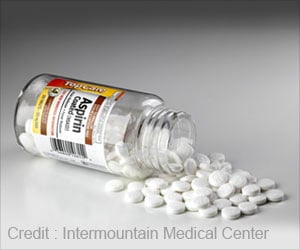- Nearly 300 million persons worldwide suffer from cardiovascular disease; it is estimated that 5-10 percent of such persons undergo an adverse event such as heart attack or stroke.
- Current study indicates that dual therapy with an anti-platelet agent such as aspirin and an anticoagulant such as rivaroxaban is more effective in reducing the risk of stroke or heart attack.
The study was undertaken to explore the possibility of further reducing the incidence of adverse events such as stroke, heart attack and death in patients with stable cardiovascular disease.
Currently the standard treatment in such patients is aspirin or a similar agent. According to Dr. John Eikelboom, efforts to further reduce risk have focused on adding another antiplatelet agent to aspirin or replacing aspirin with another antiplatelet drug such as clopidogrel. However these measures have only met with limited success.
Dr Eikelboom and his team decided to determine the safety and efficacy of a combination of an antiplatelet agent with an anticoagulant such as rivaroxaban in reducing risk of adverse cardiac events.
Details of the Study
In this randomized study, the effects of rivaroxaban at doses of 2.5 mg twice-daily combined with 100 mg of aspirin once-daily were compared to rivaroxaban 5 mg twice-daily or to aspirin 100 mg once-daily.
- Combination therapy of aspirin and rivaroxaban reduces incidence of heart attack and stroke and improves patient survival
- Combination therapy is associated with an increased incidence of gastrointestinal bleeding but not intracranial bleeds and was not associated with fatalities
In the words of Dr Eikelboom, "Using a different approach, COMPASS showed that combining aspirin with a low dose of an anticoagulant was substantially more effective than aspirin alone. Even small improvements in the effectiveness of treatments that prevent stroke and heart attack are important because cardiovascular disease is very common. In COMPASS the treatment effect was unexpectedly large."
Effect of Combination Therapy in Peripheral Arterial Disease
The same study also looked at the effectiveness of aspirin and rivaroxaban combination in preventing loss of limb or severely affecting lower limb blood flow (ischemia) in persons with peripheral arterial disease (PAD).
The participants of the study included 7470 persons with PAD. The combination therapy was shown to be effective in reducing lower limb loss and ischemia in PAD by nearly 46 percent. Similarly, the combination increased the risk of gastrointestinal bleeding but not brain hemorrhage.
The PAD aspect of the study was led by Dr Sonia Anand who states that the findings could prove to be beneficial for patients with peripheral arterial disease.
The details and findings of this study are due to be published in The Lancet soon.
Stable Heart Disease and Its Management
Stable coronary artery disease (SCAD) refers to occurrence of predictable episodes of transient central chest pain (angina pectoris), brought about by exercise, emotion or other forms of stress, due to reduced blood flow to heart in response to increased demand in persons with known risk factors. Persons known to have had obstructive or non-obstructive coronary artery disease (CAD) in the past, but currently remaining stable on medical therapy are also considered to have stable heart disease.
In persons with stable heart disease, measures to prevent adverse cardiac events and death focus on reducing the occurrence of thrombotic events and improving left ventricular function. These are achieved by a combination of lifestyle modification, pharmacological measures to control risk factors, drugs to prevent plaque progression and reduce inflammation thereby decreasing the risk of plaque rupture and thrombosis.
Towards reducing thrombotic risk, antiplatelet and anti-inflammatory agents aspirin or clopidogrel are the drugs of choice.
Although antiplatelet agents have been effective in reducing the risk of cardiac events, the current study proves that dual therapy is more beneficial in decreasing this risk in patients with stable heart disease. This is definitely good news for physicians treating heart disease as well as patients and their families.
Reference:
- Rivaroxaban for the Prevention of Major Cardiovascular Events in Coronary or Peripheral Artery Disease (COMPASS) - (https://clinicaltrials.gov/ct2/show/NCT01776424)
Source-Medindia















